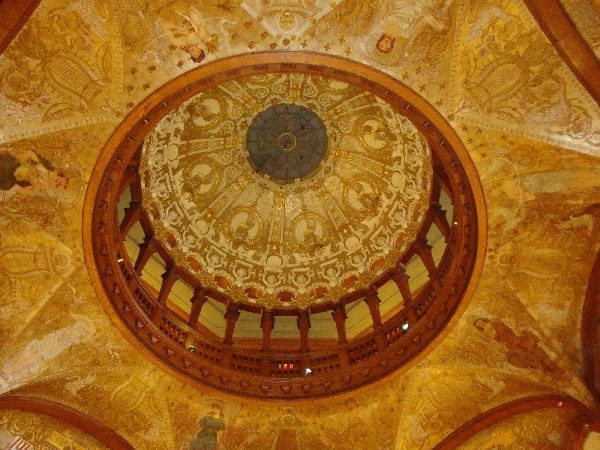
Ponce de León Hotel Dome - St. Augustine, FL
N 29° 53.556 W 081° 18.890
17R E 469602 N 3306926
The former Ponce de León Hotel is now part of Flagler College. It has a beautiful dome in the rotunda just inside the main entrance.
Waymark Code: WMBD69
Location: Florida, United States
Date Posted: 05/08/2011
Views: 17
Construction of the former Ponce de León Hotel where the dome is located was completed in 1887. The ornate dome appears to be lined primarily with a gold leaf application and beautiful murals of female figures.

The following information is from a sign posted in the former hotel lobby:
Palace in Paradise
The Ponce de Leon Rotunda
The grand entranceway of the historic Ponce de Leon has been called the most elegant room in St. Augustine. The ornate Rotunda has captivated guests and visitors since the debut of the hotel on January 10, 1888. Richly decorated, the three-and-half story dome displays spectacular murals by George Willoughby Maynard and brilliant gilding that warms dimly lit spaces.
The Rotunda is the pivotal point of the Hotel Ponce de Leon's floor plan, the crossing of the main north-south and east-west axes. In this central location hotel guests arrived, departed, socialized, waited for their carriages, or strolled to other areas of the hotel complex. The Rotunda linked the private guestroom wings (now student residences) to the public spaces of the hotel.
At the first floor level, eight caryatids (robed figures of women) carved in oak support the 80-foot dome and shape the octagonal plan of the Rotunda. Around the ornate wooden pillars, mosaic tile floors, marble and dark oak baseboards, large fireplaces, and gilded walls create the exotic atmosphere of this room. Hidden from view is a structural dome piercing the rooftop that shields a solarium. Originally balconies accessed from the solarium hosted tropical roof gardens and a breathtaking view of St. Augustine. In 1893, lion heads with electric lights were added at the mezzanine level.
On the plaster walls of the dome at the second floor level, noted muralist George Maynard painted eight elaborate female figures representing the four elements - Fire, Earth, Air and Water - and the four stages of Spanish exploration - Adventure, Discovery, Conquest and Civilization. Around these principal figures are many layers of symbolism, rendered by Maynard in meticulous detail. In 1897, ten years after their completion, Maynard reproduced these murals in the Thomas Jefferson Building of the Library of Congress.